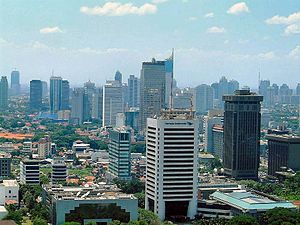
Jakarta is the capital city of the Republic of Indonesia. Indonesia is an example of a country located in the Asia-Pacific region.
Towards defining the Asia-Pacific region
In order to have an understanding of regional relations in the Asia Pacific, we first need to consider what constitutes the Asia-Pacific region. This is a term often used, but what does it actually mean? For instance, what is an Asia-Pacific country? The term ‘Asia-Pacific’ is often used as a homogenous grouping. However, this incorrectly portrays the region, which is quite diverse in many respects. Before we consider the diversity that exists in Asia and the Pacific, we must first consider which countries comprise the region. This is the purpose of our first E-learning activity for this Module.
In this Module we start by individually compiling a list of the countries that comprise the Asia-Pacific region in the e-learning activity. When compiling your list of countries, you should think about the geographic diversity contained in the region. You should also think about the different peoples, societies, cultures and climate across this region. These factors will provide further evidence of the diversity that exists in the region. You may also be intrigued by countries that fit the categorisation of an Asian-Pacific country, although they may not instantly come to mind. Just where do the boundaries lie for this very dynamic, ever-changing region of states (countries)?
After completing this learning activity, reflect on what you found when you compiled your list of Asia-Pacific countries. Consider the following:
- What did you find?
- Did your search produced reliable results?
- Are there any regions or countries you didn’t expect to be included in the Asia-Pacific search?
- Are there countries you expected to find in the region which were not listed?
Share your thoughts on WENotes below. Examples of your post:
- I was surprised by …
- This confirmed …
You must be logged in to post to WEnotes.
(Visit the course feed to read comments from participants)
From general to specific
After compiling your list of countries in the Asia-Pacific region, you will then be asked to focus on one country in particular and prepare a country profile of your selected country.
You should read about your country in-depth so you have a clear understanding of its history, society, culture and government. Your only restriction here is that the country must be located in the Asia-Pacific region. You are free to select a country you know nothing about, or one that you have always had a keen interest in or desire to travel to. This again reflects the pedagogy of discovery used in this course. After completing both of the e-learning activities, you can blog them but remember to tag them with RRAP101 so they can be harvested. The e-moderator will be able to provide feedback to your blog.
Towards defining the Asia-Pacific region
In order to have an understanding of regional relations in the Asia Pacific, we first need to consider what constitutes the Asia-Pacific region. This is a term often used, but what does it actually mean? For instance, what is an Asia-Pacific country? The term ‘Asia-Pacific’ is often used as a homogenous grouping. However, this incorrectly portrays the region, which is quite diverse in many respects. Before we consider the diversity that exists in Asia and the Pacific, we must first consider which countries comprise the region. This is the purpose of our first E-learning activity for this Module.
In this Module we start by individually compiling a list of the countries that comprise the Asia-Pacific region in the e-learning activity. When compiling your list of countries, you should think about the geographic diversity contained in the region. You should also think about the different peoples, societies, cultures and climate across this region. These factors will provide further evidence of the diversity that exists in the region. You may also be intrigued by countries that fit the categorisation of an Asian-Pacific country, although they may not instantly come to mind. Just where do the boundaries lie for this very dynamic, ever-changing region of states (countries)?
Activity
After completing this learning activity, reflect on what you found when you compiled your list of Asia-Pacific countries. Consider the following:
Share your thoughts on WENotes below. Examples of your post:
You must be logged in to post to WEnotes.
(Visit the course feed to read comments from participants)
From general to specific
After compiling your list of countries in the Asia-Pacific region, you will then be asked to focus on one country in particular and prepare a country profile of your selected country.
You should read about your country in-depth so you have a clear understanding of its history, society, culture and government. Your only restriction here is that the country must be located in the Asia-Pacific region. You are free to select a country you know nothing about, or one that you have always had a keen interest in or desire to travel to. This again reflects the pedagogy of discovery used in this course. After completing both of the e-learning activities, you can blog them but remember to tag them with RRAP101 so they can be harvested. The e-moderator will be able to provide feedback to your blog.
Content is available under the
Creative Commons Attribution Share Alike License.
Privacy Policy | Authors